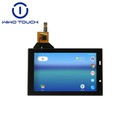-Resistance touch screen technology
-Capacitive touch screen technology
-Infrared touch screen technology
-Surface acoustic touch screen technology
Resistive touch screen technology
Resistive LCD touch screen displays rely on a touch overlay, which consists of a flexible top layer and a rigid bottom layer separated by insulating points, connected to the touch screen controller. The inner surface of each layer is coated with a transparent coating of indium tin oxide (ITO) metal oxide that promotes a gradient in each layer when a voltage is applied. Pressing the flexible top plate produces electrical contact between the resistance layers and produces a closed switch in the circuit. The control electronics alternate voltages between the two layers and pass the resulting X and Y touch coordinates to the touch controller. The data from the touchscreen controller is then passed to the computer operating system for processing. Resistive touchscreen panels are usually cheaper, but only provide 75% clarity, and the layers can be damaged by sharp objects. Resistive touch panel is not affected by dust, water and other external factors. Resistive touch screen for food service; Retail point of sale (POS), medical monitoring devices, portable and hand-held products, industrial process control and instrumentation. Resistance technologies fall into two main categories:
• Wire-blocked touch screen technology
• Wire-blocked touch screen technology
Capacitive touch screen technology
Capacitive touch screen panels are coated with a material that stores electric charge. When the panel is touched, a small amount of charge is attracted to the point of contact. Circuits located at each corner of the panel measure the charge and send the information to the controller for processing. Unlike resistive and surface wave touch screens that can be touched with a finger or stylus, capacitive touch screens must be touched with a finger. The capacitive touch screen provides excellent clarity and no wear and tear on moving parts. Liquids, dirt, grease or other contaminants will not affect them. Unfortunately, gloved fingers don't activate the system. It falls into the following two categories:
Surface capacitive technology
Projective capacitor technology
Infrared touch screen technology
Infrared touch screens use an X-Y infrared LED array and photodetector pairs around the edge of the screen to detect breaks in the LED beam pattern. A major benefit of such a system is that it can detect basically any input, including a finger, a gloved finger, a stylus or pen. It is commonly used in outdoor applications and point-of-sale systems that cannot rely on conductors, such as bare fingers, to activate the touch screen. Unlike capacitive touch screens, infrared touch screens do not require any glass patterns, which increases the durability and optical clarity of the overall system.
Surface acoustic touch screen technology
Surface acoustic wave (SAW) technology is one of the most advanced touch screen types. The technology is based on two sensors (transmit and receive) placed on the X-axis and Y-axis of the touch panel. Another important element of the SAW is placed on glass, called a mirror. The controller sends the electrical signal to a transmitting transducer, which converts the signal into ultrasonic waves and fires it onto reflectors arranged along the edge of the panel. After the reflector refracts the wave to the receiving transducer, the receiver converts the wave into an electrical signal and sends it back to the controller. When a finger touches the screen, the wave is absorbed, allowing a touch event to be detected at this point.
SAW technology provides higher image sharpness, resolution, and higher light transmittance than resistive and capacitive technologies. Because the panels are all-glass, there are no layers to wear, which makes this technology for the highest durability and highest clarity. Disadvantages of surface acoustic wave (SAW) technology include having to touch the touch screen with fingers, gloved hands, or a soft-tipped stylus (hard things like pens don't work), the touch screen is not fully sealed, and is affected by large amounts of dirt, dust, and/or water in the environment. Surface acoustic technology is recommended for use in ATMs, amusement parks, banking and financial applications, public kiosks, computer-based training, or other high-traffic indoor environments. The surface wave touch screen panel is the most advanced of the four types. SAW offers excellent clarity and durability, and allows use with gloves. However, SAWs are expensive, difficult to seal from the environment, can be inadvertently activated by dust, grease or liquids, and can be damaged by external factors.




